You are now reading part 1 of the comprehensive strength training guide that teaches you the A - Z of building muscle and strength through articles that are easy to understand. Click here to see all the articles in the guide.
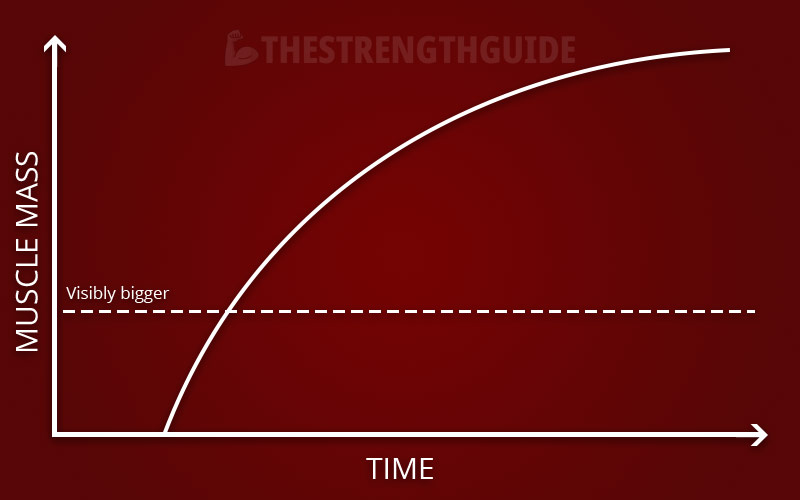
I remember myself as a skinny little guy in my youth. Maybe you could also say that I was a bit of an outcast.
I had a few close friends but was never part of the popular crowd. Maybe I was too childish for that, who knows?
This probably created a desire in me to get what I felt I wasn’t getting. That’s why I became interested in building a muscular body early on.
Not as a direct route to becoming popular, but also to build self-confidence.
I’m sure many women out there can relate to the same feelings, even if the goal wasn’t necessarily a muscular body.
I now understand that this may not have been the right way to go about it. Achieving the body you want will build self-confidence. But it’s a kind of external motivation that’s quite fragile. Real confidence comes from within.
Even as part of the process and the training needed to change the body. Showing up for training several times a week over several years builds discipline, good self-esteem, and belief in yourself.
However – this somewhat weak self-esteem had made it easy to be lured into various websites created by so-called “gurus”.
These were muscular and “ripped” men who were supposed to have the secret to achieving the perfect body.
The well-hidden secret that would guarantee me women, money, and self-confidence for the rest of my life.
I took the bait, which is also perhaps why this time was so difficult for me.
After all, all these gurus had completely different answers to the same questions. I was torn between unrealistic goals and completely beyond stupid advice.
Without any kind of background that enabled me to think critically.
The feeling I had back then – a feeling of total confusion and helplessness – I don’t wish for anyone else.
Therefore, in this part of the strength training guide, we will go through in detail what kind of results you can expect from your training. We will look at both muscle growth and increases in strength.
What you can achieve – and often what you want to achieve – depends on your genetics. The biggest single factor is which assigned gender you have.
I will split this part of the article into a section for men, and another for women. You can click the link below the heading to skip the section you don’t want to read. You’ll not miss anything important.
Rate of increase in muscle mass for men
Skip past section for men by clicking here
If we ignore differences in fat mass, a completely untrained man will look something like the picture below. Maybe even more skinny.

If you have this starting point, then you’re actually in luck. You may feel thin and weak but fear not. Your body is just waiting for stimuli to make your muscles stronger and grow.
One study showed that as a beginner, you can put on almost 7 kg of lean mass in just three months if you do everything right and respond well. Another study found an average increase of 5.6 kg of lean mass in just 10 weeks.
This will not be 100% dry muscle mass. You will also put on some water weight and marginal amounts of bone mass. The curve from complete beginner to well-trained looks something like this:

It’s in the first few months that you really make rapid progress. As your body gets stronger and your muscles get bigger, the rate of progress slows down.
If you have been training for 2 – 3 years, you can expect no more than a 1 – 2 kg increase in muscle mass per year.
That’s the reality, but believe me when I say that you will look very good after 2 – 3 years of continuous training.
If we take the physique in the picture above as a starting point, then after just 3 months of beginner progress you will be able to achieve these results:

After 2 – 3 years you will be able to look like this:

This requires that you train correctly, consistently and adjust the training plan based on your progress. You can get help with this from a local personal trainer or an online coach if you don’t feel you have the right knowledge yourself. A cheaper option could be our workout program.
Let’s take a little step back. The images above can help you set some realistic expectations.
However, the number of kilos of muscle mass you can put on over a given period may not be the best target for progress.
Take the glute muscles for example. This is the largest muscle in the entire body. Muscle growth here could lead to a relatively large increase in weight compared to other muscles in the body.
If you are a man who is more interested in getting stronger in the arms and chest than in the butt, then the weight gain will have no bearing on your goal.
It will not matter for you if you put on 2 kg of muscle mass on your butt. 1 kg of muscle mass distributed on the arms and chest will make a much bigger difference.
Therefore, it may be useful to use other measurement methods than just weight, something we will look at more in an article later in this guide.
Maximum muscle growth you can achieve as a man
Now you know a bit about how quickly you can expect to put on muscle. It is also interesting to know the maximum amount of muscle mass you can gain.
You may have seen bodybuilders such as Ronnie Coleman.
If this is a goal for you, then I can say right away that you have to go the illegal route. There is no way to achieve this without anabolic steroids (and often a pile of other drugs).
This is not something I recommend. Therefore, I want to show you some examples of what can be achieved naturally.
Here I could pull up pictures of people who say they are natural. Then I could come up with my views around whether they speak the truth or not.
I am not a fan of this route. I have no way of knowing the truth, and neither does anyone else. Thus it is pure speculation.
It is better to look at images of bodybuilders that were active a long time ago. For example, before steroids were widespread, or even better, before they existed at all.
There were three groups of scientists in Sweden, Germany, and the Netherlands who first managed to produce synthetic testosterone. The work was carried out at the beginning of the 1930s, and production was barely beginning in 1935.
Small studies were carried out with low doses on short adults, people with impaired testosterone production, and the elderly. It was not until 1942 that the drugs were tested on healthy men, and they were not recognized as muscle growth promoters on a general basis until 1945.
At that time, it cost over 500 USD to produce 1 gram of synthetic testosterone, and it would be quite some time before costs dropped.
Therefore, it is highly unlikely that any form of steroid use was taking place before 1950, and the first reported occurrence of steroid use linked to any form of sport was in 1959.
This was American football, not bodybuilding or weightlifting. It is accepted in the research that from about 1960 onwards, steroids were “relatively common” to use for people who lifted weights.
Thus, we can be reasonably certain that bodybuilders from the early 1950s and before did not have access to any form of anabolic steroids.
If we are to be even more skeptical, we can look at images from a time before steroids were recognized as generally muscle-building. Before 1944, all bodybuilders would be what we call natural.
If we want to be absolutely sure, then we can say that from the 1930s, and in any case before 1920, nobody could have used anabolic steroids to increase their muscle mass above natural levels. They simply did not exist at all.
And with that, I want to present some pictures that show what you can achieve with good genetics and proper training – without any illegal means:

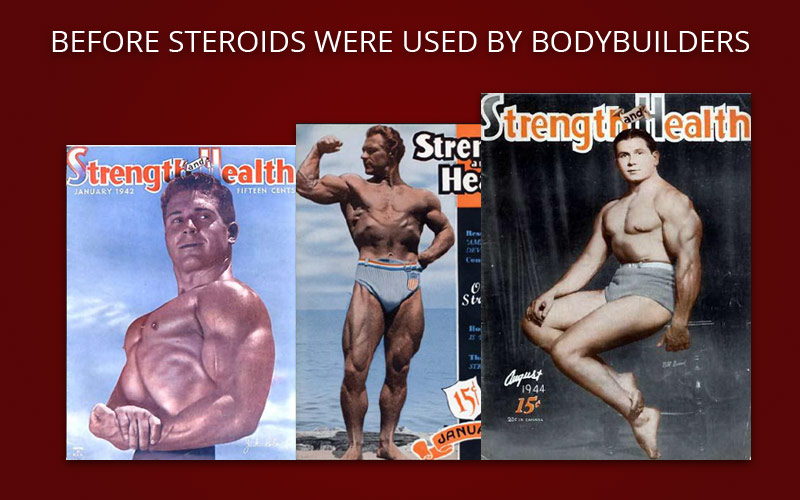
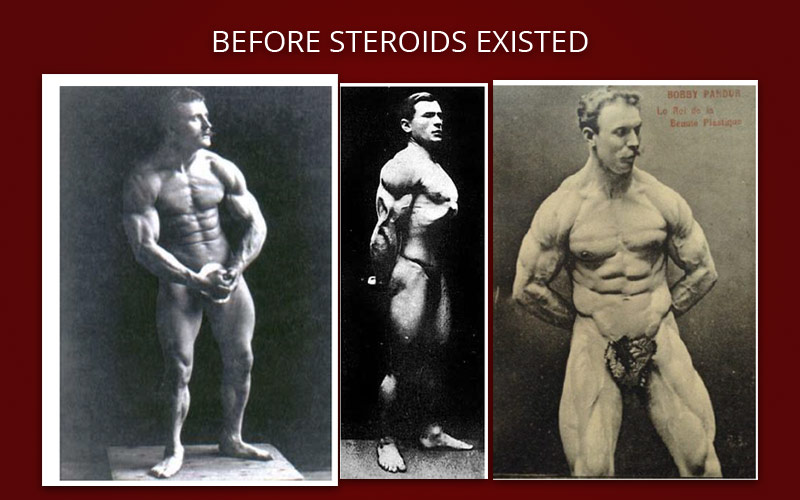
So maybe you should think twice before you scream that half the people at the gym are steroid users.
Of course, some are, but it’s far from impossible to get good results with proper training over time! Just look at the physiques – especially the upper arms and thighs – of the guys in the pictures above.
Male genetic potential calculator
So you might be wondering if there’s a way to find out what your genetic potential for muscle growth is. Exactly how big you can expect to get with proper training over the next 10 years?
There is!
A researcher called Casey Butt has created a formula for this. He analyzed the height, weight, and several other measurements of male bodybuilders. The great thing is that he included both natural and steroid-using athletes.
In addition, he used data from the era before steroids were used in sports. This allowed him to create the formula that gives you an estimate of what is possible to achieve naturally.
In addition, he came up with a measure of muscle mass that looks a bit like BMI, namely FFMI. We will examine this a little closer later in the guide.
Find a tape measure. Then measure your ankle and wrist as shown in the pictures below. Measure the ankle at the narrowest point and the wrist closest to the hand.
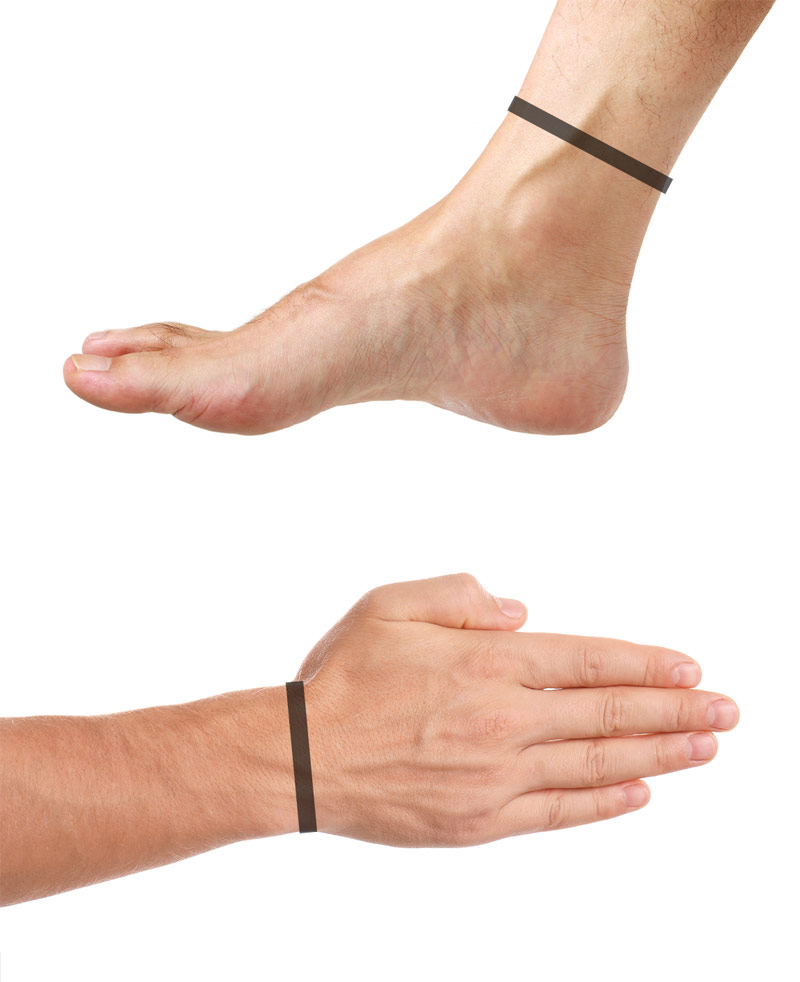
Then use this calculator to estimate your genetic potential:
Genetic Potential Calculator
Height: 180.0 cm / 5 feet 10.9 inches
Wrist: 15.0 cm / 5.9 inches
Ankle: 20.0 cm / 7.9 inches
Results at 10% body fat
Weight: 85.5 kg / 188.1 lbs
Upper arm: 40.3 cm / 15.9 inches
The calculator uses Casey Butt’s formula to work out how much you can expect to weigh at around 10% body fat. This is elite athlete status, while still having enough fat that your body does not go into crisis mode.
In addition, it calculates how big of an upper arm you can expect to achieve. The target is for the largest point of a flexed (tightened) biceps.
Note that you need 10 – 15 years of uninterrupted strength training with the right diet to achieve this. However, you can reach approximately 80% in 5 – 7 years, and 65% in just 2 – 3 years.
A target achievement of 60 – 80% gives you an incredibly impressive physique. A physique that most people would describe as “big”, “powerful” or “impressively strong”.
Women build muscle just as fast as men
Skip past section for women by clicking here
On average, women start with lower muscle mass than men.
This does not mean that it takes longer for women to reach their maximum genetic potential. In fact, as a woman, you will reach your ceiling just as quickly as a man. This requires you to train heavy, hard and avoid exercises that only waste time.
Even if you feel that you have a robust bone structure, you won’t suddenly wake up muscular one day. Don’t be afraid to train with heavy weights. You’ll have plenty of time to stop training if you find you’re getting too big.
You may think that testosterone is important for muscle growth and that women have only a fraction of the testosterone of a man. That’s true! But it turns out that testosterone is not as important for the rate of muscle growth, just how much muscle mass you start with. As a woman, you may also benefit more from the growth hormone IGF-1, and you have enough of that.
If we ignore differences in fat mass, a completely untrained woman will look something like the picture below.

Not everyone has this lean starting point, but it’s easier to illustrate increases in muscle mass when we can see the muscles of the person.
If you have this starting point, then you are very lucky. You may feel thin and weak but fear not. Your body is just waiting for stimuli to make your muscles stronger and grow.
If you’re a complete beginner, you can expect to put on around 1 – 2 kg of lean mass in just three months if you do everything right.
This will not be 100% dry muscle mass. You will also put on some water weight and marginal amounts of bone mass. The graph from complete beginner to well trained looks something like this:

It’s in the first few months that you make rapid progress. As your body gets stronger and your muscles get bigger, the rate of progress slows down.
However, this does not mean that you will not get good results. It just means that you need to have realistic expectations.
Many women are afraid of becoming lumpy, big, and muscular. This leads them to train with light weights, lots of repetitions, and not to push themselves hard. Perhaps they are influenced by bodybuilders who look like this :

I can assure you that you will probably have to take male hormones and all sorts of other substances to reach this point. It’s not realistic at all to look like that for most people.
To put it another way: If you have incredible genetics for muscle building, you will have time to stop exercising before you get too big. You don’t just wake up one day like a beast.
It’s more likely that after 1 – 2 years of consistent and proper training you’ll look like this:

If you feel that the woman in the picture above is a bit too muscular for your taste, then you will reach your goals even faster.
This requires that you train consistently with heavy weights and adjust the training plan based on your progress. You can get help with this from a local personal trainer or an online coach if you don’t feel you have the right expertise. A cheaper option could be our workout program.
Let’s take a little step back. The images above can help you set some realistic expectations. However, the amount of muscle mass you can put on over a given period may not be the best target for progress.
Take buttock muscles for example. This is the largest muscle in the entire body. Muscle growth here could lead to a relatively large increase in weight compared to other muscles in the body.
If you are a girl interested in a bigger butt, then an increase here will be in line with your goal. You may be disappointed if, on the other hand, you put on 1 – 2 kg of muscle mass on your shoulders and arms.
That’s why it can be a good idea to use other measurement methods than just weight, something we’ll look at more in an article later in this guide.
A bit about training the glutes
It hasn’t escaped my notice that many women wish their bottoms were bigger. Or tighter, as some have also told me. A lot of strange things are done to achieve this.
For example, I have seen that bicycling is promoted as a good glute exercise at various websites and forums.
Don’t get me wrong, bicycling is great. You burn fat, use your legs, exercise your heart, and get a longer life. But it’s not a good glute exercise.
It takes two things to get the butt you’re looking for. The first is bigger glute muscles. To tighten up your glutes, you need to train with heavy weights in the same way as for building other muscles.
The second thing you need is a relatively low fat percentage. You need to show off the muscles that are there, and the best way to do that is to stay within a healthy and normal range.
In this way, weight loss can help you towards your goal. But not without heavy strength training with the right exercises. This is something we will discuss more later in this guide.
Considerations for strength training women
As mentioned earlier, as a woman you should not train with light weights far away from exhaustion. At least not if you want to make progress in strength training.
There is also no way to train for “long and lean muscles”. It’s all about having enough muscle mass and not too much fat. Almost everything else is genetically determined.
You have to work with the genetics we have been given. Yet some research suggests that women can train in a slightly different way than men.
It looks like women could get better results from training with a few more repetitions than men. Maybe you can experiment with 10 – 20 repetitions per set if 5 – 10 doesn’t work for you.
This in no way means that you should train lightly. As we will see later, you must continue to train with high effort.
It is also possible that women can tolerate a higher volume and frequency of exercise than men. In practice, this means that you can have longer workouts, and you can do them more often.
If that’s not for you, that’s fine too. Even if you can tolerate more, that doesn’t mean you’ll get better results from it.
Furthermore, research shows that as a woman you can take shorter rest periods between sets than men and still get the same effect from training. It’s not entirely clear why this is the case, but we do know that hormones, muscle fiber composition, and female metabolism all play a part.
I will point out that I haven’t seen enough research on this to call it absolute truth.
I do think it might be worth experimenting a bit with these things. Especially if you don’t feel like you’re getting the results you want. Regardless, it would still be wise to stick to the general recommendations in this guide.
You can read more about training for women and the research behind it in this article from Menno Henselmans.
Improvements in strength after training
Women have the same relative potential to build strength as men. The percentage gains are similar, although the weight that can be lifted as a beginner is lower for women. The graph for a beginner looks pretty similar to the graph for muscle gains:
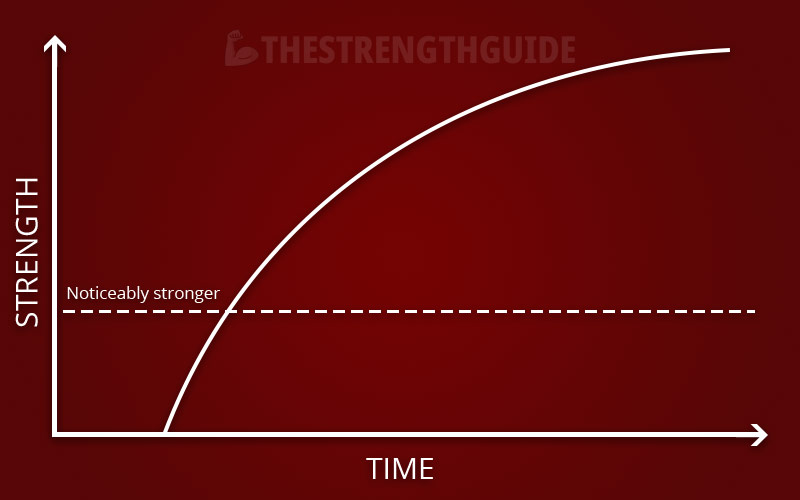
It turns out that the process for building muscle is the same as for building strength. There is no point in separating the two for people who don’t want to become elite athletes in strength-related sports.
When you start strength training, you can expect anywhere from 0% to 250% increase in a given exercise in just 3 months. The reason why the span is so large will be discussed a little bit later in this article.
First, I will just tell you a little bit about how strong you can expect to become as a natural woman or man.
To do this, we can look at the weight lifted in different exercises for powerlifters. Now, elite athletes do nothing in their day-to-day life but lift weights and eat food.
That’s why I want to look at amateur classes. In addition, we can make it a bit more realistic by looking at the junior level.
Data from The Norwegian Powerlifting Federation show that the fourth place in the Norwegian championship for raw (equipment-free) powerlifting in 2019 at the junior level for men and women in the middleweight class gave the following performances:
4th place Women’s Junior Class
Squat: 117,5 kg
Bench press: 77,5 kg
Deadlift: 135 kg
4th Place Men’s Junior Class
Squat: 195 kg
Bench press: 127,5 kg
Deadlift: 260 kg
You can therefore expect to get very strong with proper training over time, even if you don’t expect to compete. And if maximum strength isn’t necessarily the goal, it makes it even easier to achieve.
What if I have bad genetics for strength training?
A large part of your progress is governed by your genetics. Genetics is not something you can control.
Therefore, there is no point in worrying about whether they are bad or good. This is of course easier said than done. Especially if you feel that your genetics are of the more inadequate kind.
I mentioned above that you can expect a 0% – 250% increase in strength as a beginner. In the same study, some people lost muscle mass after training!
Researchers call those who don’t get stronger after training “non-responders”.
Taste that word a little bit. In practice, it means that you don’t respond to strength training. So no matter what you expose your muscles to, they won’t get bigger or stronger.
It sounds quite dramatic! So let’s dive a little deeper.
The study looked at one type of strength training for a group of different people. There was no individualization in the number of repetitions, sets, or exercises.
Nor was there any attempt to optimize diet and exercise. We know nothing about the lifestyles of the subjects.
Isn’t it therefore reasonable to assume that training and lifestyle could have been adapted and better results obtained? In fact, another study found no “non-responders” when studying older people.
As my supervisor at The Norwegian School of Sport Sciences said to me when I had these concerns: “I have never experienced that anyone who has trained consistently for a few years has not got good results”.
As mentioned earlier, this is where individualization, analysis, and possibly coaching come into play. If you see that you are not getting any effect from the training, then you can make changes that bring dramatic improvements.
It is also important not to think that you have a bad starting point for getting results from strength training.
You may have heard of the placebo effect, where the body can experience positive effects without a “real” stimulus. For example, by feeling much better after taking a sugar pill.
There is also something called the nocebo effect, which is the opposite. Here, you might tell someone that you are getting sick from the pill, and the person will feel sick. The same thing can happen to your training results.
For example, a group of men was told they were taking steroids in an exciting study. The truth was that the pills they were taking were completely ineffective.
The group of men who thought they were on steroids suddenly lifted 7 times more weight during their workout – in just half the time they were using without the sugar pill.
You should therefore have faith in yourself and the chances you have to achieve the goals you set for yourself.
Avoid the trap I fell into with gurus who promise impossible results.
Know that you have the opportunity to build new confidence, a better self-image, and a body that will be there for you for life.
That attitude could take you further than you thought possible!
Summary of the results you can expect from strength training
You can achieve much more than you might think as a man or woman in just 3 months with proper, consistent, and heavy strength training.
Women make as rapid a percentage gain as men, even if they start with less muscle mass.
There is some genetic variation between people, but everyone who trains consistently over time gets good results.

 by
by